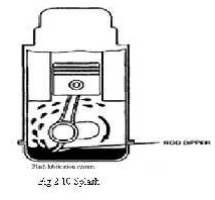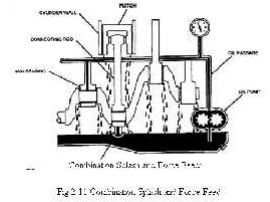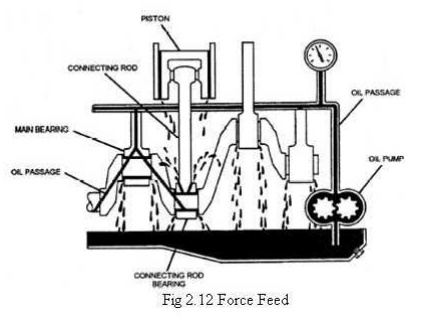Chapter: Mechanical and Electrical : Thermal Engineering : Internal Combustion Engines
Lubrication System
Lubrication
System:
Does anyone know the importance of lubrication and
cooling systems in an engine?
The
lubrication and cooling system of an internal- combustion engine is very
important. If the lubricating system should fail, not only will the engine
stop, but many of the parts are likely to be damage beyond repair. Coolant
protects your engine from freezing or overheating.
What lubrication system does for an engine?
1. The job
of the lubrication system is to distribute oil to the moving parts to reduce
friction between surfaces which rub against each other.
2. An oil
pump is located on the bottom of the engine.
3. The pump
is driven by a worm gear off the main exhaust valve cam shaft.
4. The oil
is pumped to the top of the engine inside a feed line.
5. Small
holes in the feed line allow the oil to drip inside the crankcase.
6. The oil
drips onto the pistons as they move in the cylinders, lubricating the surface
between the piston and cylinder.
7. The oil
then runs down inside the crankcase to the main bearings holding the
crankshaft.
8. Oil is
picked up and splashed onto the bearings to lubricate these surfaces.
9. Along the
outside of the bottom of the crankcase is a collection tube which gathers up
the used oil and returns it to the oil pump to be circulated again.
Purpose of Lubrication System
Lubricate
Ø Reduces
Friction by creating a thin film(Clearance) between moving parts (Bearings and
journals)
Seals
Ø The oil
helps form a gastight seal between piston rings and cylinder walls (Reduces
Blow-By)
Ø Internal
oil leak (blow-by) will result in blue smoke at the tale pipe.
Cleans
Ø As it
circulates through the engine, the oil picks up metal particles and carbon, and
brings them back down to the pan.
Absorbs shock
Ø When
heavy loads are imposed on the bearings, the oil helps to cushion the load.
Viscosity:
Ø Viscosity
is a measure of oil’s resistance to flow.
Ø A low
viscosity oil is thin and flows easily
Ø A high
viscosity oil is thick and flows slowly.
Ø As oil
heats up it becomes more viscous (Becomes thin)
Proper lubrication of an engine is a complex
process.
Motor oil must perform many
functions under many different operating conditions. The primary functions of
oil are listed below:
1. Provide a
barrier between moving parts to reduce friction, heat buildup, and wear.
2. Disperse
heat. Friction from moving parts and combustion of fuel produce heat that must
be carried away.
3. Absorb
and suspend dirt and other particles. Dirt and carbon particles need to be
carried by the oil to the oil filter where they can be trapped.
4. Neutralize
acids that can build up and destroy polished metal surfaces.
5. Coat all
engine parts. Oil should have the ability to leave a protective coating on all
parts when the engine is turned off to prevent rust and corrosion.
6. Resist
sludge and varnish buildup. Oil must be able to endure extreme heat without
changing in physical properties or breaking down.
7. Stay
fluid in cold weather; yet remain thick enough to offer engine
What the cooling system does for an engine.
1. Although
gasoline engines have improved a lot, they are still not very efficient at
turning chemical energy into mechanical power.
2. Most of
the energy in the gasoline (perhaps 70%) is converted into heat, and it is the
job of the cooling system to take care of that heat. In fact, the cooling
system on a car driving down the freeway dissipates enough heat to heat two
average-sized houses!
3. The
primary job of the cooling system is to keep the engine from overheating by
transferring this heat to the air, but the cooling system also has several
other important jobs.
4. The
engine in your car runs best at a fairly high temperature.
5. When the
engine is cold, components wear out faster, and the engine is less efficient
and emits more pollution.
6. So
another important job of the cooling system is to allow the engine to heat up
as quickly as possible, and then to keep the engine at a constant temperature.
1Splash:

The splash system is no longer
used in automotive engines. It is widely used in small four-cycle engines for
lawn mowers, outboard marine operation, and so on. In the splash lubricating
system , oil is splashed up from the oil pan or oil trays in the lower part of
the crankcase. The oil is thrown upward as droplets or fine mist and provides
adequate lubrication to valve mechanisms, piston pins, cylinder walls, and
piston rings.
In the engine, dippers on the
connecting-rod bearing caps enter the oil pan with each crankshaft revolution
to produce the oil splash. A passage is drilled in each connecting rod from the
dipper to the bearing to ensure lubrication. This system is too uncertain for
automotive applications. One reason is that the level of oil in the crankcase
will vary greatly the amount of lubrication received by the engine. A high
level results in excess lubrication and oil consumption and a slightly low
level results in inadequate lubrication and failure of the engine.
Combination
of Splash and Force Feed:

In a combination splash and force
feed , oil is delivered to some parts by means of splashing and other parts
through oil passages under pressure from the oil
pump. The oil from the pump enters the oil galleries.
From the
oil galleries, it
flows to the main
bearings and camshaft
bearings.
The main bearings have oil-feed holes or grooves that feed oil into drilled
passages in the crankshaft. The oil flows through these passages to the
connecting rod bearings. From there, on some engines, it flows through holes
drilled in the connecting rods to the piston- pin bearings. Cylinder walls are
lubricated by splashing oil thrown off from the connecting-rod bearings. Some
engines use small troughs under each connecting rod that are kept full by small
nozzles which deliver oil under pressure from the oil pump. These oil nozzles
deliver an increasingly heavy stream as speed increases.
At very
high speeds these oil streams are powerful enough to strike the
dippers directly. This
causes a much
heavier splash so
that adequate lubrication of the pistons and the connecting-rod bearings
is provided at higher speeds. If a combination system is used on an overhead
valve engine, the upper valve train is lubricated by pressure from the pump.
2.Force Feed :

A
somewhat more complete pressurization of lubrication is achieved in the force-
feed lubrication system. Oil is
forced by the oil pump from the crankcase to the main bearings and the camshaft
bearings. Unlike the combination system the connecting-rod bearings are also
fed oil under pressure from the pump. Oil passages are drilled in the crankshaft
to lead oil to the connecting-rod bearings.
The passages deliver oil from the
main bearing journals to the rod bearing journals. In some engines, these
opening are holes that line up once for every crankshaft revolution. In other
engines, there are annular grooves in the main bearings through which oil can
feed constantly into the hole in the crankshaft. The pressurized oil that
lubricates the connecting-rod bearings goes on to lubricate the pistons and
walls by squirting out through strategically drilled holes. This lubrication
system is used in virtually all engines that are equipped with semi floating
piston pins.
3.Full Force Feed:
In a full
force-feed lubrication system,
the main bearings,
rod bearings,
camshaft bearings, and the
complete valve mechanism are lubricated by oil under pressure. In addition, the
full force-feed lubrication system provides lubrication under pressure to the
pistons and the piston pins. This is accomplished by holes drilled the length
of the connecting rod, creating an oil passage from the connecting rod bearing
to the piston pin bearing. This passage not only feeds the piston pin bearings
but also provides lubrication for the pistons and cylinder walls. This system
is used in virtually all engines that are equipped with full-floating piston
pins.
Related Topics